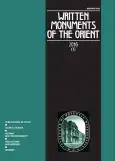The Pahlavi Lapidary
- Authors: Chunakova O.1
-
Affiliations:
- Institute of Oriental Manuscripts RAS
- Issue: Vol 2, No 1 (2016)
- Pages: 73-84
- Section: Articles
- URL: https://journals.rcsi.science/2410-0145/article/view/25781
- DOI: https://doi.org/10.17816/wmo25781-
- ID: 25781
Cite item
Full Text
Abstract
The text “The Pahlavi Lapidary” is difficult for translation and interpretation because different properties are attributed to stones of the same colour and the same properties to stones of different colours. Correct translation of Pahl. sāyišn as a concrete noun ‘a powder’ appears to explain the lapidary and to show that it is not only a question of stones of different colours, but of different coloured powders of these stones. Pahl. muhrag used not in its meaning of ‘a seal’, but in the meaning ‘a stone’ appears to suggest that this text may have been translated from a language in which there is one noun for these two meanings.
Keywords
Full Text
##article.viewOnOriginalSite##About the authors
Olga Chunakova
Institute of Oriental Manuscripts RAS
Author for correspondence.
Email: ochunakova@inbox.ru
SPIN-code: 5146-7100
Russian Federation
References
- BELENITSKII A.M. 1953: “Geologo-mineralogicheskii traktat Ibn Siny” [Geological and mineralogical treatise by Ibn Sina]. Izvestiia Otdeleniia obshchestvennykh nauk AN Tadzh. SSR [Proceedings of the Human Sciences Department of the Academy of Sciences of the Tadjik SSR] 4. Stalinabad: Izdatel’stvo Akademii Nauk Tadzh. SSR, 45-51
- BENVENISTE, Émile 1940: Textes Sogdienes édités, traduits et commentés. Paris: Geuthner
- BROCKELMANN, Carl 1928: Lexicon Syriacum. 2nd. ed. [Halis Saxonum]: M. Niemeyer
- CODICES AVESTICI et PAHLAVICI 1934: Codices Avestici et Pahlavici Bibliothecae Universitatis Hafniensis, vol. III, 1st part. Copenhagen: E. Munksgaard
- DHABHAR, Ervad Bamanji Nasarvanji 1913: The Pahlavi Rivāyat accompanying the Dādistān-ī Dīnīk. Bombay (Pahlavi Text Series 2)
- LEMMLEIN G.G. 1963: Mineralogicheskie svedeniia, soobshchaemye v tractate Biruni. [Mineralogical information reported in a treatise by Biruni]. Biruni. Sobranie svedenii dlia poznaniia dragotsennostei (Mineralogiia) [Biruni. A collection of information for studying valuables (Mineralogy)]. Leningrad: Izdatel’stvo Akademii Nauk SSSR, 292-402
- MENASCE, Jean de 1942-45: Un lapidaire pehlevie. Anthropos 37-40 (Vienna), 180-186
- PATKANOV K.P. 1873: Dragotsennye kamni, ikh nazvaniia i svoistva po poniatiiam armian v XVII v. [Gems, their names and properties as perceived by the Armenians in the 17th c.]. St. Petersburg: Tipografiia Imperatorskoi Akademii Nauk
- PIGULEVSKAIA N.V. 1979: Kul’tura siriitsev v srednie veka [Syriac culture during the Middle Ages]. Moscow: Izdatel’stvo Nauka, Glavnaia redaktsiia vostochnoi literatury
- RUSKA, Julius 1912: Steinbuch des Aristoteles mit literargeschichtlichen Untersuchungen nach den arabischen Handschriften der Bibliothèque Nationale. Heidelberg: N.-L. Kirchhain
- RUSKA, Julius 1896: Das Steinbuch aus der Kosmographie des Zakarijâ ibn Muḥammad ibn Maḥmûd al-Ḳazwînî. Heidelberg: N.-L. Kirchhain
- SEMENOV A.A. 1912: Iz oblasti vozzrenii musul’man Srednei i Iuzhnoi Asii na kachestva i znachenie nekotorykh blagorodnykh kamnei i mineralov [About the ideas the Moslems of Central and South Asia have in regard to the properties and values of certain gems and minerals]. Mir islama [The Islamic world], vol. 1(3). St. Petersburg: Izdanie Imperatorskogo obshchestva vostokovedeniia, 293-321
- WILLLIAMS A.V. 1990a: The Pahlavi Rivāyat Accompanying the Dādestān-ī Dēnīg. Part I: Transliteration, Transcription and Glossary. Historisk-filosofiske Meddelelser 60(1). Copenhagen: Commissioner: Munksgaard
- WILLLIAMS A.V. 1990b: The Pahlavi Rivāyat Accompanying the Dādestān-ī Dēnīg. Part II: Translation, Commentary and Pahlavi Text. Historisk-filosofiske Meddelelser 60(2). Copenhagen: Commissioner: Munksgaard
Supplementary files







